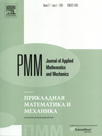 | | Journal of Applied
Mathematics and Mechanics
Russian Academy of Sciences | | Founded
in January 1936
(Translated from 1958)
Issued 6 times a year
ISSN 0021-8928
(print version) |
Archive of Issues
| Total articles in the database: | | 10482 |
| In Russian (ΟΜΜ): | | 9683
|
| In English (J. Appl. Math. Mech.): | | 799 |
|
| << Previous article | Volume 72, Issue 3 / 2008 | Next article >> |
| L.V. Stepanova and M.Ye. Fedina, "Self-similar solution of a tensile crack problem in a coupled formulation," J. Appl. Math. Mech. 72 (3), 360-368 (2008) |
| Year |
2008 |
Volume |
72 |
Issue |
3 |
Pages |
360-368 |
| Title |
Self-similar solution of a tensile crack problem in a coupled formulation |
| Author(s) |
L.V. Stepanova (Samara, Russia, lst@ssu.samara.ru)
M.Ye. Fedina (Samara, Russia) |
| Abstract |
Using a self-similar variables, an asymptotic investigation is carried out into the stress fields and the rates of creep deformations and degree of damage close to the tip of a tensile crack under creep conditions in a coupled (creep-damage) plane formulation of the problem. It is shown that a domain of completely damaged material (DCDM) exists close to the crack tip. The geometry of this domain is determined for different values of the material parameters appearing in the constitutive relations of the Norton power law in the theory of steady-state creep and a kinetic equation which postulates a power law for the damage accumulation. It is shown that, if the boundary condition at the point at infinity is formulated as the condition of asymptotic approximation to the Hutchinson-Rice-Rosengren solution [Hutchinson JW. Singular behaviour at the end of a tensile crack in a hardening material. J Mech Phys Solids 1968;16(1):13-31; Rice JR, Rosengren GF. Plane strain deformation near a crack tip in a power-law hardening material. J Mech Phys Solids. 1968;16(1):1-12], then the boundaries of the DCDM, which are defined by means of binomial and trinomial expansions of the continuity parameter, are substantially different with respect to their dimension and shape. A new asymptotic of the for stress field, which determines the geometry of the DCDM and leads to close configurations of the DCDM constructed using binomial and trinomial asymptotic expansions of the continuity parameter, are established by an asymptotic analysis and a numerical solution of the non-linear eigenvalue problem obtained. |
| Received |
16 May 2007 |
| Link to Fulltext |
|
| << Previous article | Volume 72, Issue 3 / 2008 | Next article >> |
|
 If you find a misprint on a webpage, please help us correct it promptly - just highlight and press Ctrl+Enter If you find a misprint on a webpage, please help us correct it promptly - just highlight and press Ctrl+Enter
|
|

 Russian
Russian  English
English